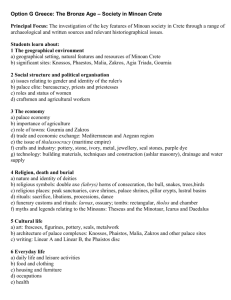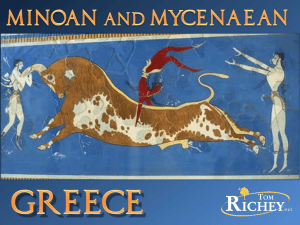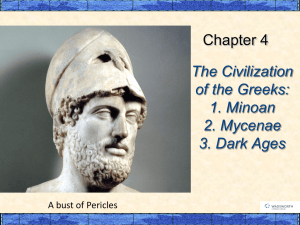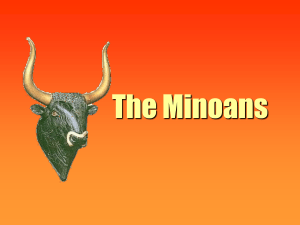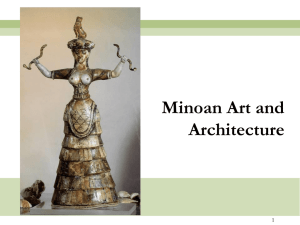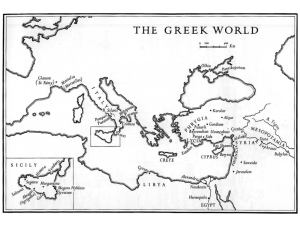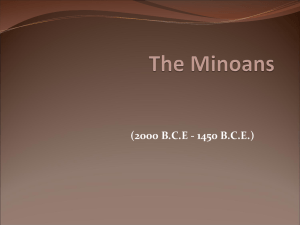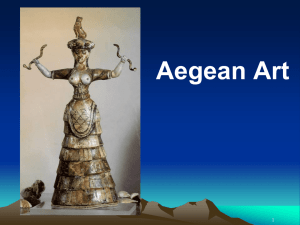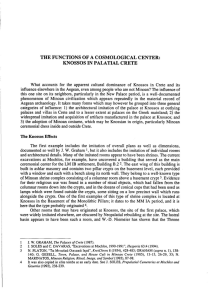AP ART HISTORY: SHMERYKOWSKY AEGEAN ART PRE-GREEK ART WORK: AEGEAN ART
advertisement
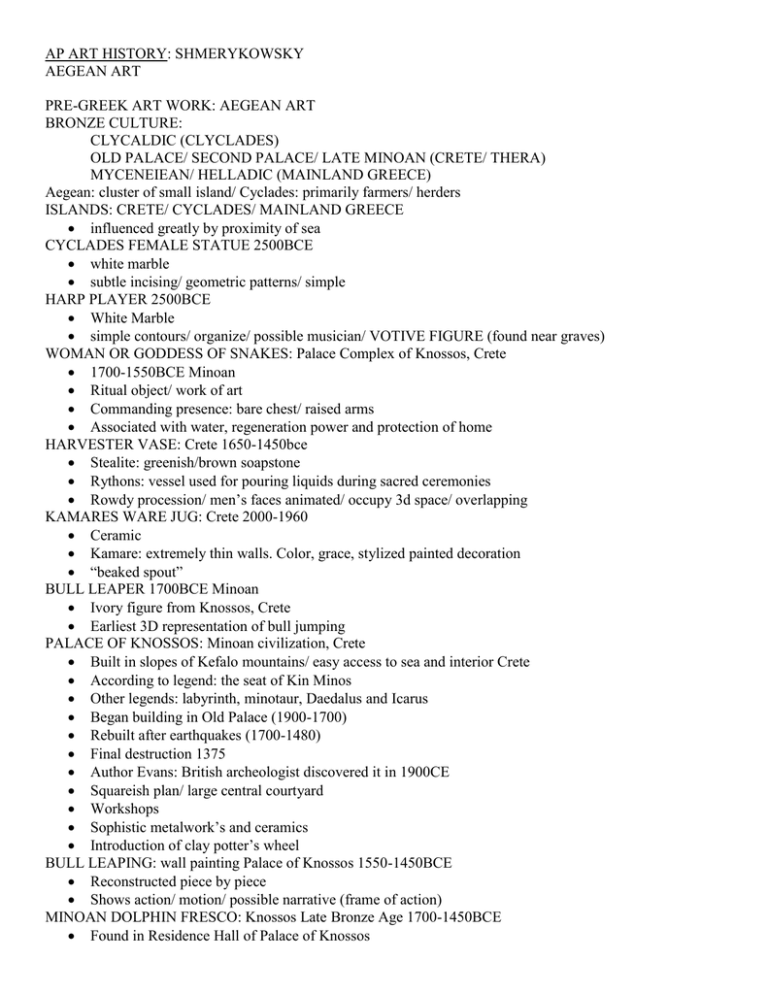
AP ART HISTORY: SHMERYKOWSKY AEGEAN ART PRE-GREEK ART WORK: AEGEAN ART BRONZE CULTURE: CLYCALDIC (CLYCLADES) OLD PALACE/ SECOND PALACE/ LATE MINOAN (CRETE/ THERA) MYCENEIEAN/ HELLADIC (MAINLAND GREECE) Aegean: cluster of small island/ Cyclades: primarily farmers/ herders ISLANDS: CRETE/ CYCLADES/ MAINLAND GREECE influenced greatly by proximity of sea CYCLADES FEMALE STATUE 2500BCE white marble subtle incising/ geometric patterns/ simple HARP PLAYER 2500BCE White Marble simple contours/ organize/ possible musician/ VOTIVE FIGURE (found near graves) WOMAN OR GODDESS OF SNAKES: Palace Complex of Knossos, Crete 1700-1550BCE Minoan Ritual object/ work of art Commanding presence: bare chest/ raised arms Associated with water, regeneration power and protection of home HARVESTER VASE: Crete 1650-1450bce Stealite: greenish/brown soapstone Rythons: vessel used for pouring liquids during sacred ceremonies Rowdy procession/ men’s faces animated/ occupy 3d space/ overlapping KAMARES WARE JUG: Crete 2000-1960 Ceramic Kamare: extremely thin walls. Color, grace, stylized painted decoration “beaked spout” BULL LEAPER 1700BCE Minoan Ivory figure from Knossos, Crete Earliest 3D representation of bull jumping PALACE OF KNOSSOS: Minoan civilization, Crete Built in slopes of Kefalo mountains/ easy access to sea and interior Crete According to legend: the seat of Kin Minos Other legends: labyrinth, minotaur, Daedalus and Icarus Began building in Old Palace (1900-1700) Rebuilt after earthquakes (1700-1480) Final destruction 1375 Author Evans: British archeologist discovered it in 1900CE Squareish plan/ large central courtyard Workshops Sophistic metalwork’s and ceramics Introduction of clay potter’s wheel BULL LEAPING: wall painting Palace of Knossos 1550-1450BCE Reconstructed piece by piece Shows action/ motion/ possible narrative (frame of action) MINOAN DOLPHIN FRESCO: Knossos Late Bronze Age 1700-1450BCE Found in Residence Hall of Palace of Knossos Arthur thought it may have been Queens private reception room OCTOPUS FLASK: Palaikastos, Crete Second Palace 1500-1450BCE Marine Style Natural forms with stylized design VAPHEIO CUP 1650-1450BCE Sparta, Greece (Mainland) Gold relief design Repousse: technique Scene: depicting men trying to capture bulls in various ways Olive trees= sacred groves figure dominate landscape illustrations depict somehow long lost heroic tale rather than common herding scene MASK OF AGAMEMNON 1600-1550 Funerary mask from Royal Tomb: GROVE CIRCLE, Mycenae Greece Found over the body of deceased One sheet of gold hammered into image Discovered by Heinrich Schliemann (1876): believed it was legendary Greek leader Agamemnon “SO CALLED” TREASURY OF ATREUS 1300-1200BCE Mycenae, Greece About 1600BCE kings and princes began building above ground tombs: bee-hive tombs Remained half buried until excavated in 1878 Cyclopean construction 120ft long and 20 ft wide Corbel vault Courses/ ashlar Chevron design
